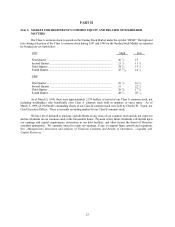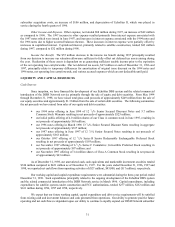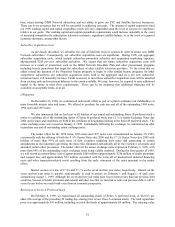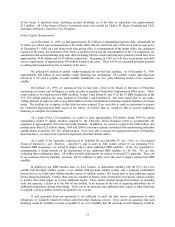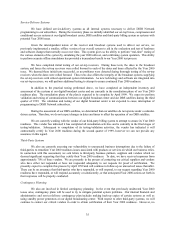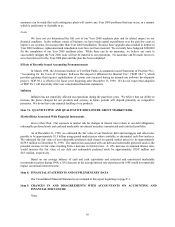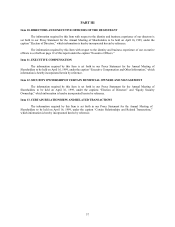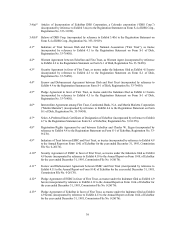Dish Network 1998 Annual Report Download - page 35
Download and view the complete annual report
Please find page 35 of the 1998 Dish Network annual report below. You can navigate through the pages in the report by either clicking on the pages listed below, or by using the keyword search tool below to find specific information within the annual report.33
of the Series A preferred stock, including accrued dividends, as of the date of repurchase was approximately
$21 million. All of the shares of Series A preferred stock were owned by Charles W. Ergen, President and CEO,
and James DeFranco, Executive Vice President.
Future Capital Requirements
As of December 31, 1998, we had approximately $1.5 billion of outstanding long-term debt, substantially all
of which was retired upon consummation of the tender offers and the concurrent sale of the seven and ten year notes.
At December 31, 1998, on a pro forma basis after giving effect to consummation of the tender offers, the concurrent
issuance of the notes, the retirement of the Series A preferred stock and the consummation of the 110 acquisition, our
unrestricted cash and outstanding long-term debt (including both the current and long-term portions) would have been
approximately $354 million and $2.07 billion, respectively. Beginning in 1999, we will have semi-annual cash debt
service requirements of approximately $94 million related to the notes. There will be no scheduled principal payment
or sinking fund requirements prior to maturity of the notes.
We utilized $91 million of satellite vendor financing for our first four satellites. As of December 31, 1998,
approximately $60 million of such satellite vendor financing was outstanding. The satellite vendor financing bears
interest at 8 ¼% and is payable in equal monthly installments over five years following launch of the respective
satellite.
On February 26, 1999, we announced that we had sent a letter to the Board of Directors of PrimeStar
expressing our desire and willingness to make an offer to purchase PrimeStar’s high-powered DBS assets. These
assets consist of two high-powered DBS satellites, Tempo I and Tempo II, and 11 of the 32 DBS frequencies at the
119° WL orbital position, the same location as EchoStar I and EchoStar II. Our letter stated that we are ready,
willing and able to make an offer to pay $600 million of total consideration (including assumed liabilities) for these
assets. The deadline for a response to this letter has since expired. If we were able to reach an agreement to acquire
the PrimeStar high-powered DBS assets in the future, we believe that we would be able to procure additional
financing to complete the transaction.
As a result of the 110 acquisition, we expect to incur approximately $35 million during 1999 for capital
expenditures related to digital encoders required by the Cheyenne digital broadcast center to accommodate the
expansion to approximately 500 video and audio channels. In addition, we expect to expend over $100 million, and
perhaps more than $125 million, during 1999 and 2000 in one-time expenses associated with repositioning subscriber
satellite dishes toward the 110° WL orbital location. If we were able to acquire the high-powered assets of PrimeStar
described above, we may not be required to reposition subscriber satellite dishes.
As a result of the anomalies experienced by EchoStar III and EchoStar IV (see “Notes to Consolidated
Financial Statements” and “Business – Satellites”), and in order to fully exploit certain of our remaining FCC-
allocated DBS frequencies, we intend to deploy one or more additional DBS satellites. If the 110 acquisition is
consummated, it would provide for the deployment of two additional DBS satellites at 110° WL. We are also
evaluating other contingency plans. All of these possible deployments are subject to several FCC approvals. There can
be no assurance that net insurance proceeds will be sufficient to fully cover the costs to deploy replacement DBS
satellites.
In addition to our DBS business plan, we have licenses, or applications pending with the FCC, for a two
satellite FSS Ku-band satellite system, a two satellite FSS Ka-band satellite system, and a proposed modification
thereof and a Low Earth Orbit Mobile-Satellite Service G-satellite system. We would need to raise additional capital
for the foregoing purposes. Further, there may be a number of factors, some of which are beyond our control or ability
to predict, that could require us to raise additional capital. These factors include unexpected increases in operating
costs and expenses, a defect in or the loss of any satellite, or an increase in the cost of acquiring subscribers due to
additional competition, among other things. There can be no assurance that additional debt, equity or other financing,
if required, will be available on terms acceptable to us, or at all.
If cash generated from our operations is not sufficient to meet our debt service requirements or other
obligations, we would be required to obtain cash from other financing sources. There can be no assurance that such
financing would be available on terms acceptable to us, or if available, that the proceeds of such financing would be


